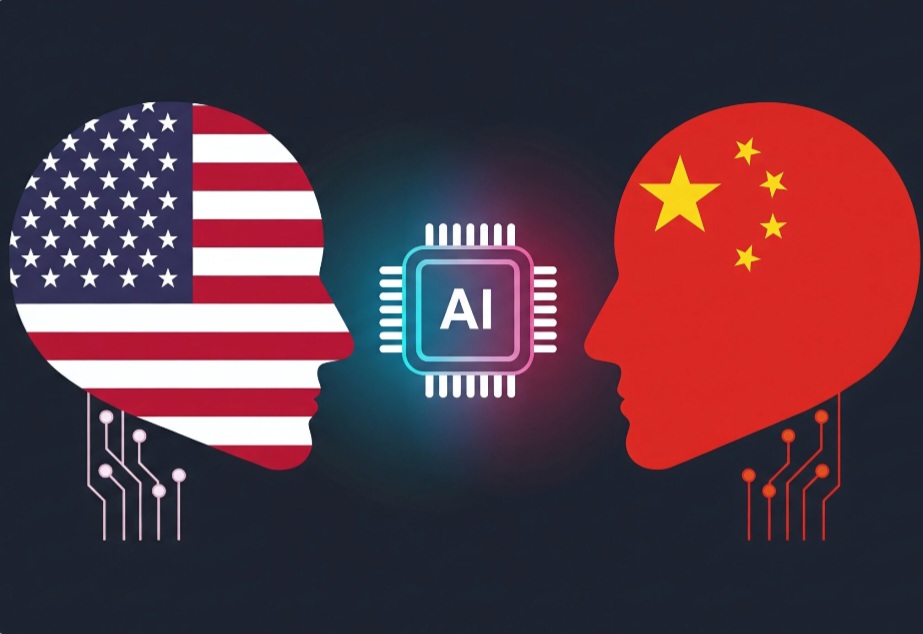By: Lt Col JS Sodhi (Retd), Editor, GSDN

October 04, 1957 which marked the launch of the world’s first artificial satellite Sputnik 1 by USSR, shocking and surprising the USA who since the end of World War I had been the global leader in technology having taken over the mantle from Germany, gave birth to a new lexicon “Sputnik Moment”.
Without much delay, the USA promulgated the National Aeronautics and Space Administration (NASA) Act on July 29, 1958 and NASA officially opened on October 01, 1958 and thereafter the USA raced on to become the global space leader.
Sample this. When Bill Gates founded Microsoft in the USA in 1975, China was in the midst of the Cultural Revolution which bluntly put, was a social upheaval revolving on anti-intellect factor. And when Larry Page & Sergei Brin founded Google in the USA in 1998, only 0.2% Chinese had access to internet as compared to 30% Americans.
As the USA increased it scientific prowess, it became the global leader in science and technology and in the year 2000 produced 18,289 Doctorates (PhDs) in Science, Technology, Engineering & Mathematics (STEM). That year China produced just 9038 PhDs in STEM.
In China the internet started on April 20, 1994 and in the USA on April 01, 1983.
From the period 1994 to 2010, China was known infamously “copy-catting” American cyber technology. And in this duration number of Chinese small-time companies mushroomed across China trying to make the financial kill in this “copy-cat technology” business. Thus, started the “war of copy-cats”.
However, 2010 was the year in China when something started silently that would in the next 15 years give the world another Sputnik moment. On January 20, 2025 when DeepSeek, the Chinese artificial intelligence software that develops open-source Large Language Models (LLMs) was announced, China’s “Artificial Intelligence Sputnik Moment” stunned the world.
The fact that the date of announcement of DeepSeek on January 20, 2025 on the same day as of the inauguration of Donald Trump as the 47th President of USA was no coincidence but a well-planned strategy to show China’s biggest rival that it meant business.
A week later, President Donald Trump reacted by terming DeepSeek as a “Wake-up Call” as during the first week of its launch, DeepSeek surged to become the most downloaded free application displacing OpenAI’s ChatGPT. Eric Schmidt, former CEO of Google termed the launch of DeepSeek as a turning point in the global AI race.
China’s Artificial Intelligence (AI) ecosystem started gaining ground in 2010 when Guo Hong, a Chinese government official, realising the potential of cybernetics started transforming Zhongguancun, a shanty and dirty suburb of Beijing to create China’s Silicon Valley.
Three years later, in 2013, Zhongguancun’s name was changed to Chuang Dajie which means “avenue of entrepreneurs” in Chinese language after it had metamorphized into a swanky suburb. By this time the dust started settling for “the war of copy-cats” in China and the Chinese Information Technology (IT) firms that survived “the war of copy-cats” now had office space in Chuang Dajie, which offered three-year free rent and Chinese government backed Venture Capitalist (VC) funds coming in a big way.
During the period 2010-2014, VC funds worth US$ 3 billion were given to the Chinese IT firms and in the year 2015, it rose dramatically to US$ 26 billion after the China’s State Council (equivalent of the US President’s cabinet) approved the setting up of Mass Innovation and Mass Entrepreneurship scheme in consequence to Prime Minister Li Keqiang’s announcement on September 10, 2014 in Tianjin.
The Mass Innovation and Mass Entrepreneurship scheme marked a pivotal shift in China from manufacturing-led growth to innovation-led growth. Thus, started China’s pursuit for supremacy in Artificial Intelligence.
In March 2016 China announced the China Brain Project, which was to be a 15-year effort that would prioritise brain-inspired AI over other approaches.
On July 08, 2017 China announced the New Generation AI Development Plan which aimed to advance AI development in China in three stages with the final aim of China becoming the world leader in AI by 2030. The announcement of DeepSeek in 2025 confirmed that China is well on the track for global supremacy in AI.
By the time the Russian President Vladimir Putin remarked on September 04, 2017 that the nation that leads in Artificial Intelligence (AI) will be the ruler of the world, China was already galloping ahead in the AI world.
Few days later, on November 01, 2017 during the Artificial Intelligence and Global Security Summit in Washington, Eric Schmidt warned against complacency when it came to Chinese AI capabilities.
PricewaterhouseCoopers, a multinational firm widely recognised as one of the “Big Four” accounting firms, headquartered in London has estimated that by 2030, AI will add up US$ 15.7 trillion to the global GDP of which China’s share will be US$ 7 trillion and US’ share will be US$ 3.7 trillion.
China’s AI foray into modern Warfare & Implications for the Taiwan War
It was but natural that sooner or later, China would use AI to foray in the defence sector as China has been clear in its military aims since the Chinese Civil War ended in 1949. The first military target for China is Taiwan, for which it will wage a war in 2027.
Unlike in the West and for a major part of the world where Chess as a game is popular, in China the game Go is played widely which like Chess is a two-player game but unlike Chess which aims at eliminating the game pieces, Go aims at controlling more territory.
Go pretty much explains the Chinese war strategy too. Incapacitate the enemy through non-kinetic means first and then launch kinetic warfare.
In October 2015, Google launched the game AlphaGo virtually, which soon became a sensation in China.
In May 2017 when AlfaGo defeated Kie Jie who was the world champion in Go, watching this game being telecast live on the Chinese television channels, were some Generals of the People’s Liberation Army (PLA) in the headquarters of the Central Military Commission (CMC) in the August 1st Building in Beijing.
In the days to come numerous conferences were held in the August 1st Building which also houses China’s Ministry of Defense apart from the CMC, between the military & civil officials and it was decided that AI will be incorporated in China’s weapon systems.
The New Generation AI Development Plan announced by China on July 08, 2017 had a latent aim beneath the civil sounding nomenclature of the plan – use of AI in defence. And there wasn’t much time to waste as the war for Taiwan, the first military target for China, was just a decade away in 2027.
China had well understood that if AI is the new electricity that will play the pivotal role in the future wars, then Big Data is the oil that will power the generators to produce the electricity called AI.
By 2019 China had become the largest global depository of Big Data.
China has replaced its conventional defence networks with cloud network that have the capability to process and communicate at each point of usage. With 5.5G in every PLA network, the autonomy in Chinese weapon systems are at lightning speed level, which has started worrying the US military.
PLA is using AI-driven decision making to accelerate decision cycles and improve strategic planning after the AI systems have predicted potential threats for optimal strategic responses.
Machine learning algorithms are processing Big Data for developing machine learning algorithms that will support rapid decision making and enhance operational efficiency, for China is aware that in case the USA decides to intervene militarily when China attacks Taiwan in 2027, the warring faction that is technologically superior will have the first mover advantage.
On April 13, 2024, China developed the world’s first AI-enabled water canon that has revolutionized non-lethal combat in maritime disputes. Equipped with photoelectric camera & motion sensors, this water canon can automatically identify targets and adjust their power and trajectory in real-time.
On December 31, 2024, China placed orders for one million AI-enabled lightweight kamikaze drones to its top ten drone manufacturing companies under strict & secret agreements with the timeline of delivery as December 31, 2026.
China not only has started incorporating AI in its conventional weapon systems but also in its nuclear weapons. On September 10, 2024 China refused to sign the “Blueprint for Action” agreement in Seoul which seeks to ban AI from controlling nuclear weapons.
China has shown to the world yet again that if policies and plans are implemented in a specific time frame with accountability and responsibility, one decade is enough to reach global leadership in any field.
On June 25, 2025, Mark Rutte, the NATO Secretary General alarmed the world about the massive Chinese military buildup and potential for Taiwan invasion. Little earlier, on May 31, 2025, Pete Hegseth, the US Defence Secretary warned that China is actively training to invade Taiwan.
The admission of Pete Hegseth on April 12, 2025 that China could destroy the 11 aircraft carriers of the US Navy in just 20 minutes and that all the internal war games of the US military indicated the USA losing to China. War games are conducted in all militaries the world over to assess the readiness of military strategies and are designed to simulate real-war scenarios. This candid confession of the US Defence Secretary is a grim reflection of how ill-prepared is the USA to thwart China’s war for Taiwan in 2027.
Clearly, China has out-manoeuvred the USA in Artificial Intelligence which will have grave implications for Taiwan and the world in 2027.

About the Author
Lt Col JS Sodhi (Retd) is the Founder-Editor, Global Strategic & Defence News and has authored the book “China’s War Clouds: The Great Chinese Checkmate”. He tweets at @JassiSodhi24.

